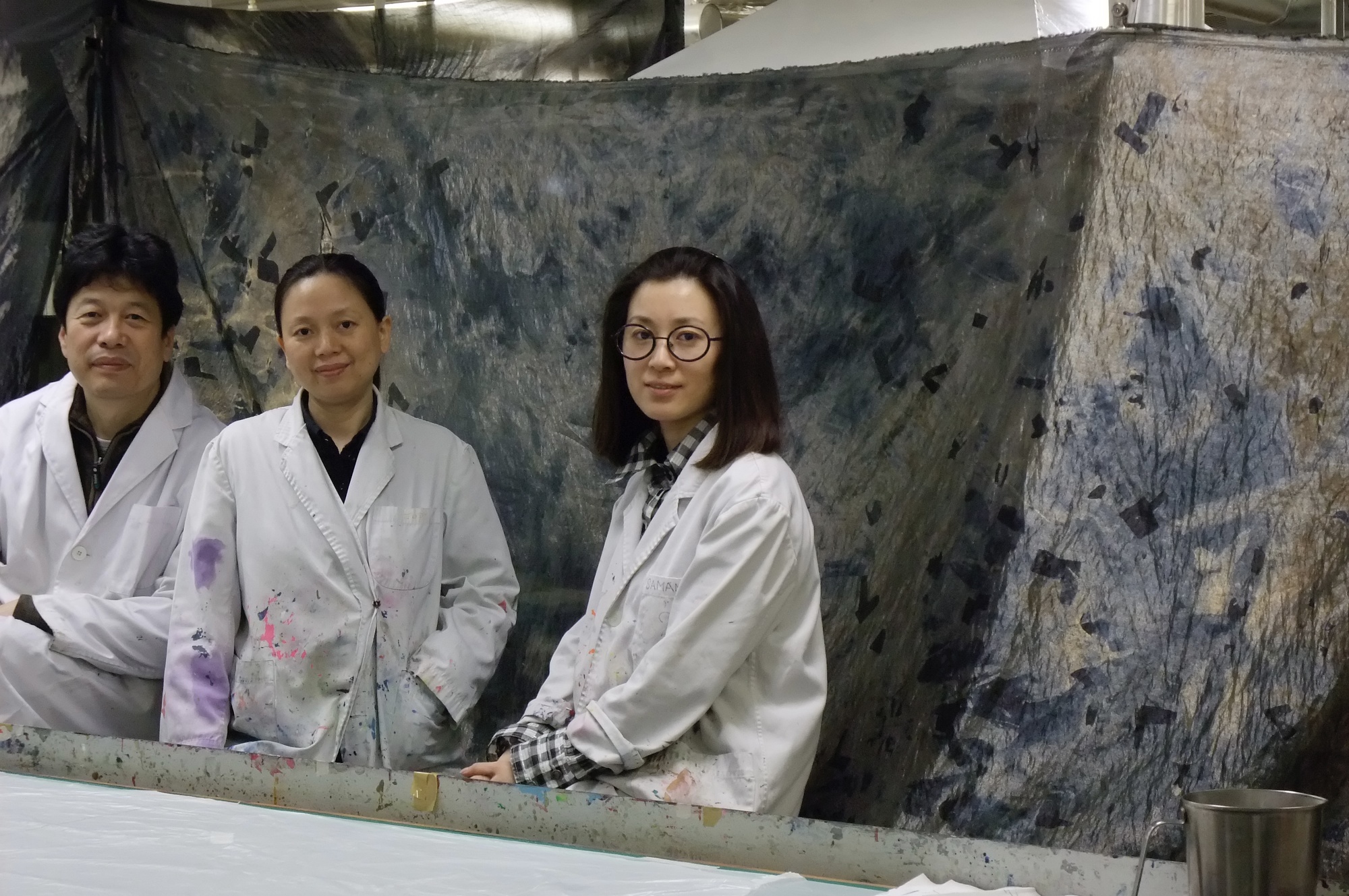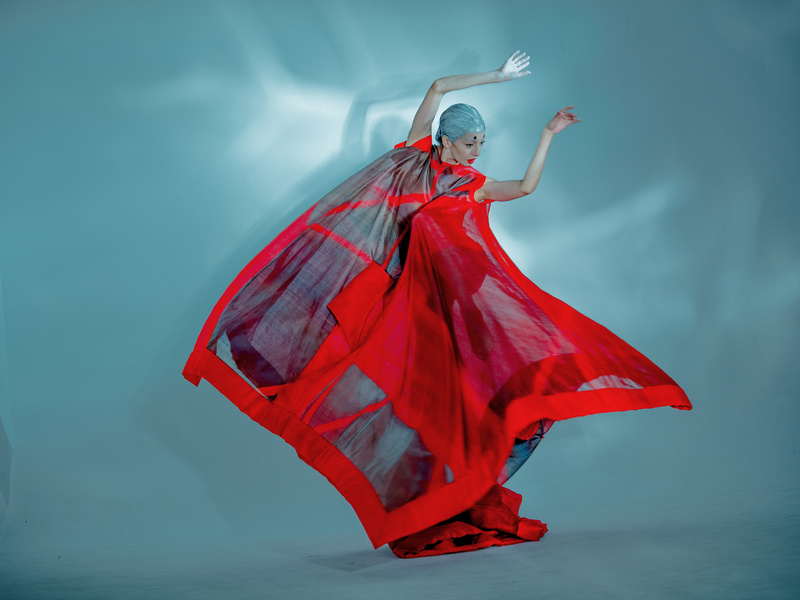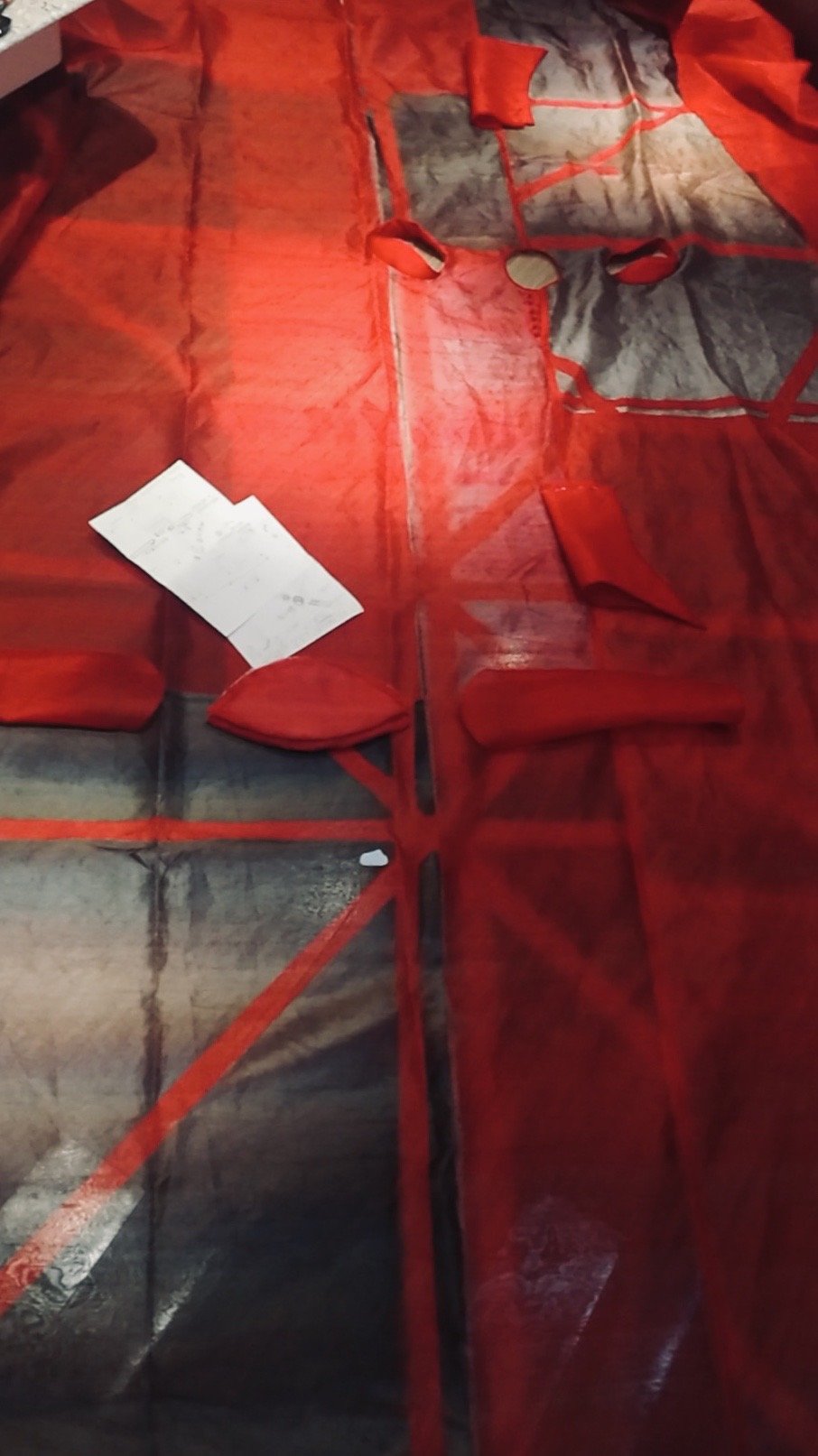
Kinor Jiang & Rui Xu
In 2009, under the leadership of Professor Kinor Jiang, Sue Sun, and Rui Xu conducted research and textiles in the laboratory at The Hong Kong Polytechnic University, simultaneously carrying out four distinct experimental studies.
Details of Silver Coated Tussah
The core technology of this fabric lies in the application of silver molecules onto tussah silk, a traditional textile from Shandong Province. Crafted in 2009, by Prof. Kinor initially, this textile was carefully placed by Rui in a completely light-proof wooden box, allowing only minimal air circulation. Each season, Rui would retrieve it to document its evolving colour. Over time, the silver layer gradually oxidised, as if it had absorbed the essence of the passing seasons-spring, summer, autumn, and winter-the shifting hues of dawn and dusk, the rhythm of rain and snow, and the ever-changing splender of the sky. Through this transformation, the once fresh and radiant silver deepened into a patina of age and timeworn beauty.

The Cutting Pattern
In the process of designing the pattern, I found myself caught between two compelling forces. On one hand, the intricate beauty of each small piece captivated me, making it almost unbearable to cut them away. On the other hand, the symbolic auspiciousness of the flat-cutting technique in traditional Chinese clothing intrigued me, turning the act of tailoring into a playful exploration. This fascination led me to further extend my experimental approach to pattern-making in Xiang Wang Yi.
The fabric itself was huge, allowing me to incorporate three collars and four cuffs-openings that paradoxically did not reduce the fabric but instead introduced additional layers, enriching the structure. Through this process of transformation and integration, the garment evolved into a rhythmic composition of voluminous waves, yet maintained an inherent sense of order.
This design also unveiled multiple possibilities for wearability, enabling the garment to be worn by either one or two person, expanding its interpretative potential. When ballet dancer Amy performed in it, she embodied a powerful yet effortless sense of relaxation, revealing a unique aesthetic where movement and stillness converged into a harmonious expression.
The 'Circularity' of 'Heaven' merging into the 'Squareness' of 'Earth'
The 'Circularity' of 'Heaven' merging into the 'Squareness' of 'Earth'
The Zhoubi Suanjing, one of the oldest Chinese mathematical texts from the ancient Zhou dynasty (1046-771 BCE), dedicated to astronomical observation, calculation and mathematics says: “The square pertains to Earth, and the circle pertains to Heaven. Heaven is circular, and Earth is square." Yet the terms Heaven and Earth in Chinese culture reflect underlying laws which govern the Universe as opposed to being shapes or physical entities in themselves. It is Heaven, which sets forces in motion, which the Earth subdues to. All of the myriad beings on Earth take part in this dance of Heaven and Earth, like microcosms of a sublime macrocosm.
Zengzi recorded a passage from his teacher Confucius, who stated that 'Heaven' refers to the laws of unceasing transformation and the complex cyclical motion of vital qi, a subtle life force, which underlies and guides all manifestations in the Universe. While 'Earth', refers to the laws governing existence, the immense diversity of objects in the universe, which all have their own special function. Heaven and Earth depend on each other. One moves one is still, one is light one is dark, one is circular one is square, one exhales one absorbs, one is Yin and one is Yang, this is the way of Heaven and Earth, interacting opposites within a whole. Neither pole can be lacking, as they both mutually support one another.
Although modern science explains the universe with more precise data than the conceptual 'square' or 'circular' worldview, the underlying philosophy of 'Heaven being circular and Earth being square' has already been widely accepted by people. The force emanating from the 'circular' symbolizes movement and instability, flexibility and adaptation, like the alternation of the Earth and the Moon and the changing of the seasons. The squareness that absorbs this force symbolizes stillness and stability, rules and power, such qualities exhibited on Earth and from the architecture springing from the world of men.
I have kept this sheet of Shandong wild silk for over ten years already. With the passage of time and the oxidation process it is undergoing, the glowing 'silver' coating experiences unceasing transformations. It reminds me of time-lapse photography of the sky over the sea as different colors manifest from minute to minute. This is a reflection of the 'forces of Heaven', natural laws not influenced by the will of man. I often take this silk out to photograph its changes, to observe how the myriad objects all have their own vital qi or life force. It fascinates me how moment by moment this life force works away, in silence, regardless of whether we pay attention to its existence or not.
The "circle" of "heaven" merges into the "square" of "earth"
The earliest astronomical and calendar work in China, Zhou Bi Suan Jing, said: "Fang belongs to the territory, the circle belongs to the sky, and the sky is round". It means: circle is exhalation, attribute is heaven; Fang is qi; The attribute is the earth, and all things on the earth contain qi.
Zeng Shen recorded a passage from the teacher Confucius, believing that "heaven" is characterized by the impermanence of essence and the complex movement of circulation. "Earth" is based on the existence of different things with their special functions. Heaven and tunnel, one move and one stillness, one circle and one side, one breath and one acceptance, one yang and one yin; They are different, but also indispensable and support each other.
Although modern science uses more precise data to explain the universe, rather than the "round" or "rectangular" point of view, the philosophy of "heaven and place" has been generally accepted. The "exhaling circle" symbolizes activity and instability, flexibility and flexibility, such as the alternation of the sun and the moon, and the change of stars, while the "qi square" symbolizes stillness and stability, rules and power, such as the earth and architecture.
I have sealed this silk-squeezed Shandong silk for more than ten years. The brilliance of "silver" plated on its surface is constantly changing in the passage of time due to the oxidation process. Like the seaside sky in slow motion, the color is different every minute. This just reflects that the natural law of "exhaling heaven" is not transferred by human will. I often take out photos and record them to witness that everything has its own "qi". Every moment this "qi" is doing its own work, in a quiet way, whether we pay attention to its existence or not.
The Circularity of Heaven merging into the Squareness of Earth
Rooted in ancient Chinese cosmology and mathematical thought, this work explores the philosophical relationship between Heaven and Earth-a dynamic balance of movement and stillness, lightness and weight, fluidity and structure. The Zhoubi Suanjing, one of the oldest Chinese mathematical texts dedicated to astronomy and mathematics, describes the universe with the concept: “The square pertains to Earth, and the circle pertains to Heaven ."
Rather than mere geometric forms, these concepts symbolize fundamental cosmic forces. Heaven represents ceaseless transformation, cyclical motion, and the vital qi that animates all things, while Earth embodies stability, materiality, and the structured existence of myriad beings. Their interaction defines the natural order-one moves, the other remains still; one exhales, the other absorbs; one is Yin, the other is Yang. This delicate equilibrium underscores the inseparability of opposites, a principle deeply embedded in Chinese philosophical traditions.
Through the medium of Shandong wild silk, coated with silver, this work materializes the subtle dance of time and transformation. Over years of oxidation, the silver surface evolves organically, echoing the ephemeral shifts of the sky-from dawn to dusk, from season to season. By documenting these changes, the work serves as a meditation on the impermanence of material existence and the silent, relentless force of qi that shapes the world, whether acknowledged or not.
This work engages deeply with traditional Chinese philosophy, particularly the cosmological principles of Heaven and Earth and their ongoing interaction. While modern science explains the universe through precise data, the ancient worldview of Heaven as circular and Earth as square continues to inform cultural consciousness. This perspective not only shaped traditional Chinese art and architecture but also guided the design of garments, ritual objects, and city planning-where round forms signified cosmic alignment, and square structures represented earthly stability.
By using Shandong wild silk, a material historically valued in Chinese textile craftsmanship, this work also reflects the interplay between tradition and transformation. Silk, as a living fabric, absorbs and records its environment over time. The silver-coated surface, through oxidation, undergoes a visual metamorphosis that mirrors the ever-changing heavens-a poetic metaphor for natural laws that transcend human intervention.
This process of observing and documenting the material's evolution embodies the Daoist notion of “wu wei” (effortless action)-allowing nature to unfold in its own rhythm rather than imposing control. By capturing these silent transformations, the work invites reflection on the unseen energies shaping both material and spiritual realms. It highlights how traditional Chinese thought continues to offer a framework for understanding the fluid relationship between nature, time, and human experience in contemporary creative practice.
Rui Xu - Designer, Artist, and Advocate for Ecological Fashion
Rui Xu is a London-based fashion designer and contemporary artist, a fellow of the Royal Society of Arts and the China Fashion Association, and a PhD candidate at Brunel University. She founded Ruixu Studio in 2016 after receiving an Exceptional Talent visa, focusing on ecological fashion. Previously, she served as Associate Professor and Director of Fashion at CAFA (2004-2016) and studied at the Royal College of Art (2014-2015).
Her works have been exhibited at Christie's, the V&A Museum, Saatchi Gallery, and Zaha Hadid Design Gallery, with permanent collections at the V&A, Clarence House, and the China National Silk Museum. In 2017, she established Ruixu Art Limited, promoting eco-friendly design. Her clients include King Charles III, Queen Camilla, and Dame Zaha Hadid. Committed to sustainable innovation, most of her designs use recycled or recyclable materials.












